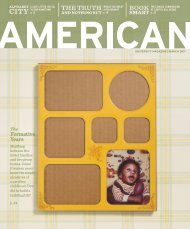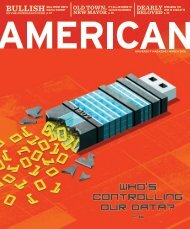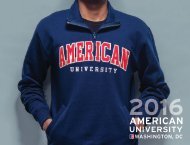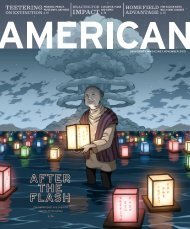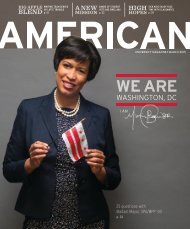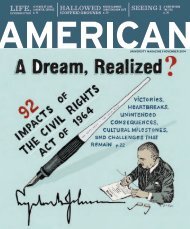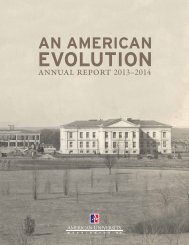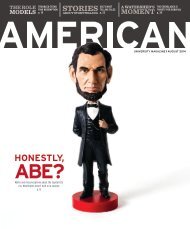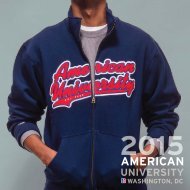American Magazine: November 2016
In this issue, delve into the Scandal-ous life of Judy Smith, meet ESPN’s new public editor, reflect on a decade of transformation under President Neil Kerwin, and learn more about autism—the fastest growing developmental disorder in the United States. Hop on the Metro to Capitol South and get to know a few of AU’s 1,068 Seattle transplants.
In this issue, delve into the Scandal-ous life of Judy Smith, meet ESPN’s new public editor, reflect on a decade of transformation under President Neil Kerwin, and learn more about autism—the fastest growing developmental disorder in the United States. Hop on the Metro to Capitol South and get to know a few of AU’s 1,068 Seattle transplants.
You also want an ePaper? Increase the reach of your titles
YUMPU automatically turns print PDFs into web optimized ePapers that Google loves.
news<br />
Four decades after the death<br />
penalty became legal again in the<br />
United States, the issue remains<br />
as polarizing as ever. School<br />
of Communication professors<br />
Richard Stack and Maggie<br />
Burnette Stogner are staunch<br />
opponents of capital punishment,<br />
but they’ve taken a decidedly<br />
nonjudgmental approach to<br />
examining it in their forthcoming<br />
documentary, In the Executioner’s<br />
Shadow, which explores how our<br />
decisions about the death penalty<br />
define who we are as individuals,<br />
as a society, and as a country.<br />
“We’ve tried very hard to make<br />
this a balanced piece so that a<br />
vast range of perspectives are<br />
represented,” Stack says. “We’d<br />
like the public to begin talking<br />
about the death penalty in deeper,<br />
more meaningful ways, and we’d<br />
like to get people getting beyond<br />
their differences and talking about<br />
some common ground.”<br />
The film follows three main<br />
characters whose beliefs and<br />
experiences vary widely. Vicki<br />
and Sylvester Schieber’s daughter,<br />
Shannon, was raped and murdered<br />
when she was 23, yet they opposed<br />
the death penalty for her killer.<br />
For years, it was Jerry Givens’s<br />
job to carry out death sentences.<br />
As Virginia’s executioner, he<br />
ended the lives of 62 men<br />
before he resigned and began<br />
advocating for the abolition of<br />
capital punishment. This summer,<br />
Stogner filmed Givens in the nowdefunct,<br />
crumbling old Eastern<br />
State Penitentiary in Philadelphia,<br />
capturing strong images she thinks<br />
will impact audiences this subject<br />
normally doesn’t reach.<br />
“It’s the perfect metaphor for a<br />
decaying, nonfunctioning criminal<br />
justice system,” she says. “Putting<br />
him in that situation is visually<br />
powerful and engaging. It’s also<br />
a metaphor for what haunts<br />
him every day, which is that he<br />
came very close—within days—of<br />
executing an inmate who was later<br />
found to be innocent.”<br />
The final protagonist is Karen<br />
Brassard, who was wounded in the<br />
2013 Boston Marathon bombing.<br />
She struggled with what would<br />
constitute justice for the man who<br />
carried out the terrorist attack.<br />
“We’d like the<br />
public to begin<br />
talking about the<br />
death penalty<br />
in deeper, more<br />
meaningful ways.”<br />
-Richard Stack<br />
“She let us into her thought<br />
process as it unfolded over<br />
the years,” Stack says. “As<br />
she wrestled with it, she very<br />
thoughtfully explored a lot of<br />
issues around what it really<br />
means to want the death penalty.”<br />
The collaboration, which has<br />
also included many graduate<br />
students, started in 2013. In<br />
addition to the film, Stack and<br />
Stogner are developing a suite<br />
of materials about the death<br />
penalty that they hope can be<br />
used to reach wider audiences<br />
and stimulate conversations in<br />
classrooms or discussion groups.<br />
It’s a timely issue. Twenty<br />
states have now outlawed the<br />
death penalty. If that number<br />
reaches 26, opponents may<br />
attempt to take a case to the<br />
Supreme Court, arguing that the<br />
punishment is not only cruel, but<br />
unusual as well.<br />
“That is the heart and soul of<br />
what this is about,” Stogner says.<br />
“What is justice?”<br />
In recent months, the role of university<br />
endowments has come under renewed<br />
scrutiny. Some believe that as nonprofits<br />
that enjoy tax-exempt status, institutions of<br />
higher education should be required to spend<br />
more of their endowments on improvements<br />
like reducing student debt and making<br />
college more affordable for low-income<br />
students. US Rep. Tom Reed (R-NY) supports<br />
legislation that would penalize institutions<br />
with large endowments that do not spend<br />
enough on student aid.<br />
AU’s $600 million endowment is<br />
comprised primarily of gifts that have been<br />
designated for specific purposes—and cannot<br />
legally be used for anything else.<br />
“Our spending policy is 5 percent of the<br />
endowment value, based on a rolling threeyear<br />
average,” says Doug Kudravetz, AU’s<br />
CFO and vice president and treasurer. “We<br />
are required to spend it based on restrictions<br />
imposed by the donors, primarily on<br />
scholarships, fellowships, and faculty chairs.”<br />
Endowments are intended to provide<br />
a long-term economic buffer, says<br />
Terry Flannery, AU’s vice president of<br />
communication.<br />
“A strong endowment roughly equal to<br />
the annual operating budget is important for<br />
bond ratings, so the university can borrow<br />
money or issue bonds for important projects<br />
and pay the debt back over time,” she says.<br />
“We have reduced student debt and increased<br />
affordability through other means.”<br />
While AU’s endowment has increased<br />
113 percent since 2005 and is now about<br />
the size of its operating budget, some of<br />
its competitors have endowments many<br />
times larger than their operating budgets,<br />
Kudravetz says.<br />
“[Ours] does not yet have the value or<br />
flexibility of some of the nation’s wealthiest<br />
institutions to contribute to operating<br />
resources in a meaningful way,” he says.<br />
“For many years AU has been primarily a<br />
tuition-driven institution and will continue<br />
to be so in the near term. But with careful<br />
investment and more ambitious fundraising,<br />
we will ensure that AU will be less dependent<br />
on tuition alone in the long term.”<br />
BROOKINGS BOUND<br />
RESEARCH WITHOUT BORDERS<br />
SPA’s Bradley Hardy has been awarded the Brookings Institution’s Okun-Model Fellowship for<br />
the <strong>2016</strong>–2017 academic year. The prestigious fellowship—typically given to academics with two<br />
to six years of experience—will enable Hardy to build relationships with Brookings scholars<br />
researching poverty, social policy, and economic instability. “I’m looking forward to working with<br />
such talented economic scholars on issues that matter to the <strong>American</strong> people,” he says.<br />
SIS and the Center for Latin <strong>American</strong> and Latino Studies have launched<br />
the Robert A. Pastor North America Research Initiative, named for the late<br />
scholar. AU will recruit six to nine academics from Canada, Mexico, and<br />
the United States, who will convene twice a year to share research and<br />
brainstorm promising new directions for policy, advocacy, and scholarship.<br />
FOLLOW US @AU_AMERICANMAG 11





